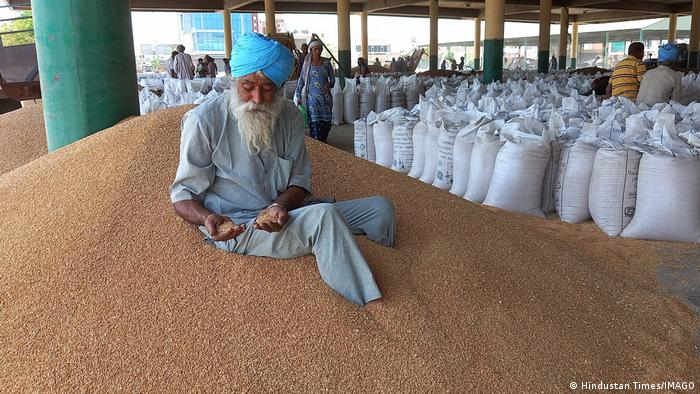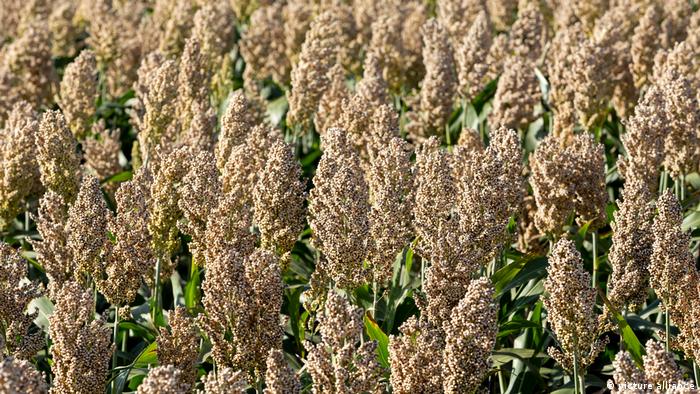How can India protect its food security under extreme weather conditions?
A recent heat wave caused India to ban wheat exports. Experts say adapting farming practices and growing more millets can ensure India's food security.

India has banned all wheat exports
Russia's war on Ukraine disrupted wheat supplies and drove up food prices across the globe, as the two countries are the top two exporters. India, the third biggest exporter, stepped in to fill the gap in the global market.
But India banned the export of wheat with immediate effect, although exceptions are being made for some countries. The announcement came just two days after announcing that it was eyeing a record push on wheat shipments this year.
Days ago, India also announced it would restrict sugar exports to stabilize prices and ensure supply. India is the second-largest exporter of sugar in the world.
Before the wheat export ban, India had set a goal of shipping a mammoth 10 million tons this year, looking to capitalize on the global disruptions to wheat supplies from the war and to find new markets for its wheat in Europe, Africa and Asia.
Food security under threat
Amid a severe heat wave and rising domestic prices, India's Directorate of Foreign Trade said the food security of India along with neighboring and vulnerable nations was under threat.
India saw the hottest March since records began in 1901. Wheat grains usually ripen around this period, which is why they are extra sensitive to heat.
With extreme weather conditions expected to become more common in the future, concerns are being raised about India's food security.
India received requests to supply over 1.5 million tons of wheat from countries that are looking to prevail over the ongoing shortage of the commodity, with the bulk of the request coming from neighboring Bangladesh.
Extreme weather changing growth patterns
Namrata Ginoya, climate resilience expert at the World Resources Institute, says India's food security has become more vulnerable to extreme weather, unpredictable rainfall and other climate factors.
"These events have a quick impact on food production, and since we are continuing on the high-emissions trajectory right now, we will see a lot of impact," Ginoya told DW.
Ginoya said there are several ways farmers can adapt to the changing weather conditions, and these practices are being followed on a smaller scale.
"We're seeing summers arrive earlier than the previous years. That is the time when the grains grow in the crop. If the temperature at the time is higher than 30-31 degrees Celsius [86-88 degrees Fahrenheit], it is bad for the growth of grains," Ginoya said.
So, farmers can start sowing the grain 10-15 days earlier than usual. Changes can also be made in the irrigation and fertilization of crops, to adapt to the weather," she added.
She believes people need to move towards a style of farming in which every stage of production is monitored and researched, and farmers can access and utilize the findings of the research.
"We also need to identify areas where it is sustainable to grow wheat, and regions where it is no longer viable to grow the crop," she told DW.
RECORD TEMPERATURES HIT INDIA'S FARMERS
Air conditioners and blocks of ice
India is currently experiencing an exceptional heat wave. Rajgarh, a city of 1.5 million people in central India topped out at 46.5 degrees C (116 degrees F) while thermometers in nine other cities also climbed above the 45 degree mark. No wonder that anything to fight the heat is an easy sell on the streets of New Delhi.
1234567
Millet as an alternative
Even with changes in climate practices, wheat and rice may not be able to fulfill the domestic and international demands of the crop.
Under these circumstances, some experts believe it is time to turn to millet, or nutri cereals, to fulfill the food requirements of the world.
"I think we can expect more and more extreme climate events, and heat waves will exacerbate in the future," Ruth DeFries, professor of ecology and sustainable development at Columbia University told DW.
"We also know that coarse cereals, or what are now called as nutri cereals, such as jowar, bajra, raagi, have the physiology of being resilient. They have lower water demands and higher tolerance to coarse soils and heat," she added.
Due to their high levels of iron, fiber and certain vitamins, they are still grown in more than 130 countries. Yet they only play a significant role in the diets of some 90 million people in Africa and Asia, and are often regarded as food for the poor.
By comparison, around half the global population relies on rice, and more than one-third on wheat.
The United Nations has declared 2023 as the International Year of Millets, which could lead to changes in how these grains are perceived.
However, substituting peoples' diets with the more commonly consumed rice and wheat could prove challenging.
"Historically, nutri cereals were a part of the diets of many people in India, but that has declined over the last two decades. But now they are seen more commonly in grocery stores and restaurants, as they are a different kind of food and good for your health too," said DeFries.

Sorghum, a type of millet, is known as jowar in India
Edited by: Leah Carter
No comments:
Post a Comment